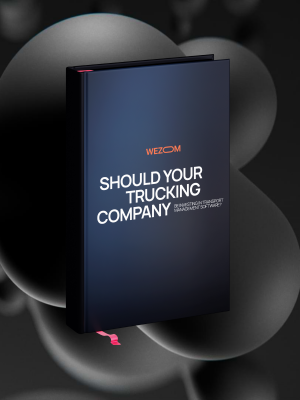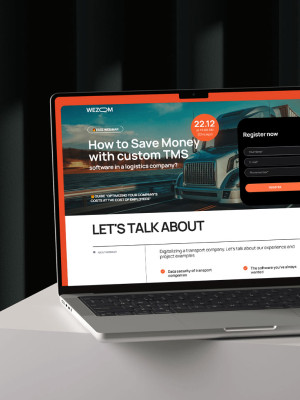Cross-border transportation can be defined as the systems and processes that facilitate the transit of goods and individuals over international boundaries. It involves utilizing various infrastructures and overseeing the seamless flow of cargo and passengers across different countries' borders. It encompasses the essential activities necessary to facilitate smooth international transit, merging both transborder and crossborder transportation avenues. To engage in cross-border driving, obtaining approval and registration as a carrier is mandatory.
Cross-border transportation presents unique challenges for fleet managers and drivers, and the COVID-19 pandemic has only heightened these difficulties with a new set of regulations and procedures. This article provides an in-depth guide on handling cross-border transportation, focusing on the trade relationship between the United States and Mexico, essential documentation for border crossing, and advice for dispatchers and drivers.
One of the biggest trading partners of the United States is Mexico.
Over $600 billion worth of commodities, including automobiles, machinery, electronics, consumer goods, pharmaceuticals, and other items, traverse our southern border annually.
A truckload is used for 83% of that cross-border freight transportation.
Even though it happens frequently—nearly 35,000 trucks cross the border between Mexico and the United States every day—it is more complicated than a domestic truckload. There may be setbacks, uncertainties, and frustrations, just like on any journey and although there are dangers to be aware of, there is also no reason to be alarmed.
Essential Documents Required for Border Crossing
Preparation is key when it comes to border crossing, with specific paperwork and data required to prevent delays.
While each cargo is unique and may require additional documentation, here is a rundown of the essential documents needed for most freight shipments:
Bill of Lading (BOL)
Before you fill out this contract between the freight carrier and the shipper, you will need a customs broker.
Additionally, it gives the driver and carrier all the information they need to process and properly bill the freight shipment, including the shipper's address and contact data as well as a description of the products being transported, including their size and weight.

Business Invoice
The importer can clear the items with customs with the use of this document.
To fully complete this form, you must have the following data, which must correspond to the data on the BOL:
- The vendor's full name, address, and nation
- Full name and address of the consignee
- A thorough summary of each package's contents
- Gross/Net weight
- Cost per unit for each item (using the payment currency)
- Increased price
- Payment method
- Delivery and payment conditions
- The day that shipments of the products began
- There are references.
- Import permit (if applicable)
- Shipping fees and insurance
- Carrier Details
The codes used to identify the carriers moving the freight on either side of the border will be required by the customs broker.
This code is known as the carrier's Harmonized Alphanumeric Code (CHAC) in Mexico and the standard Alpha Carrier Code (SCAC) in the United States (CAAT for its acronym in Spanish).
Origin Certification
A universal Certificate of Origin was required by the United States, Canada, and Mexico under NAFTA to demonstrate that imported goods were eligible for preferential tariff treatment.
While proof of origin is still required under the USMCA, there is no set manner in which it must be presented.
Customs Clearance Document of Operations (DODA)
The Mexican government is implementing more digital workstreams in an effort to simplify trade.
On behalf of the carrier, the customs broker creates the DODA on the website of the Mexican Tax Administration Service. It is necessary for the carrier to pass customs.
The DODA (an abbreviation stemming from Spanish) is created by the customs broker for the carrier using the Mexican Tax Administration Service's online platform. This document is essential for the carrier to successfully pass through customs.
United States Customs Declaration
Before a truck arrives at a U.S. border crossing, carriers must send an automated cargo manifest (e-Manifest) to U.S. Customs and Border Protection.
A pro tip: Not all cross-border loads are created equal; depending on your specific shipment, you could require additional documentation. An expert customs broker can assist you in this situation.
Advice for Dispatchers and Drivers
1. Verify That Your Dispatcher is Licensed
A solid awareness of the concepts and technical terms used in the trucking sector, such as route management, truckload, spot market, pallet exchange, etc., is essential for dispatchers in this field.
2. Develop Connections with Both Internal and External Parties
Always keep in mind that logistics is a people-based industry. Maintaining positive working relationships with all important parties in the road logistics process is crucial. For a smooth and effective planning and order execution process, keeping excellent contact with the end customer, your own sales staff (if relevant), and especially with the truck drivers is essential.
3. Employ Software for Truck Dispatching Management
The duties of a truck dispatcher are extremely varied, ranging from determining the fastest, least expensive routes to giving the driver the transit order.
By using truck dispatch management software — backed by logistics and transportation software development — you remove the guesswork from operations, improve budgets, and free up time for other pursuits. As a result, you spend less time manually completing tasks and have better communication.
4. A Single Truck Dispatching Communication System
The contact with all stakeholders accounts for a significant portion of the truck dispatching process. Again, having a truck dispatch management tool makes it simple to try to convert the strain of communication into a solitary trustworthy method.
This unifies all trip data into a single, user-friendly application, allowing you to exchange data from a single source across several channels as opposed to using many platforms one at a time.
5. Reasonable Truck Driver Expectations
‘Mission Impossible assignments’ are actions with minimal to no margin for mistakes for the drivers. Rushing delivery times result in grumpy truckers, which may lower the efficacy and efficiency of the transport process. It is advised to set up this route planning with an adequate compliance buffer instead. Manage the site manager and driver expectations in advance.
It is advised that you set reasonable expectations by informing drivers and subcontractors of when they can anticipate receiving a dispatch order from you each day and what information they will receive in order to ensure appropriate communication practices (tour time schedules, license plate, etc.).
Please keep in mind that truck drivers should remove their sunglasses, as well as turn off any radios, cell phones, onboard computers, or anything that will distract the border guards.
6. Improve the Scheduling of Drivers and Subcontractors
The first stage in creating an effective tour itinerary for all drivers, which must adhere to driving time and rest period laws while keeping a stable and lucrative tour, is to have an overview of the collection truck and driver availability.
As a truck dispatcher, you may prevent scheduling issues and bad reviews from your truck drivers by being aware of this. Once you have availability, give your drivers priority based on their dependability and productivity, and use early release times as a reward for good behavior.
7. Forward Planning Enhances Truck Dispatching
By preventing last-minute changes, planning ahead can help a transportation dispatcher save a lot of time and boost overall productivity when crossing the border. In this regard, dispatching management software for trucks might assist you in making plans.
Truck dispatchers must know in advance your transportation costs, driving times, border wait times, availability of trucks, the capacity of trucks, etc. Utilizing aiding software allows dispatchers to have access to this knowledge sooner in the planning phase, preventing schedule changes and, in the worst-case scenario, delayed transports.

Final Thoughts
Cross-border transportation is a complex process that requires careful planning, thorough documentation, and excellent communication. While challenging, with the right knowledge and tools, commercial vehicles can traverse the continent smoothly. Stay informed about entry requirements, laws, and regulations of each nation to ensure smooth transit. When crossing borders, both operators and their drivers need to be fully informed of their duties and obligations.
Managing truck dispatching is no small feat. It requires a high level of responsibility, organization, focus, and patience. Make use of advanced software tools to automate and streamline processes. Remember, it's crucial to set reasonable expectations, foster strong relationships, and plan meticulously. By doing so, you'll not only ensure a successful border crossing but also contribute to the efficient operation of the vast trade network between the US and Mexico.
So take your time, double-check everything, and set off on your journey. Here's to successful travels and seamless border crossings!




